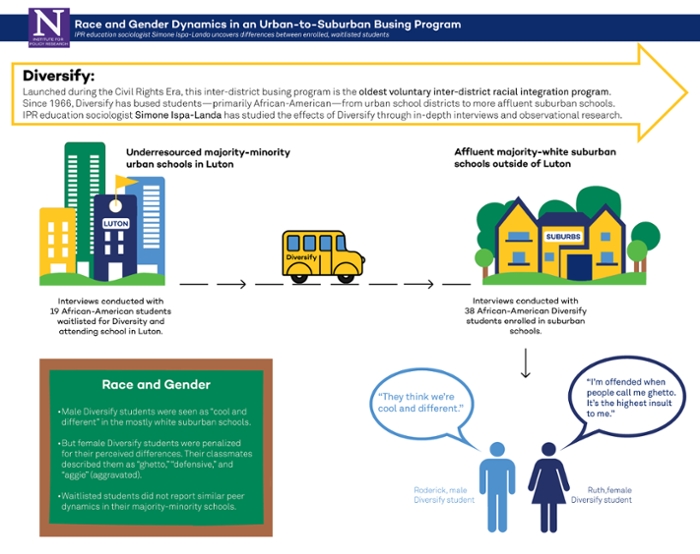Infographic: Race and Gender in Urban-to-Suburban Busing Program
IPR education sociologist studies school integration through in-depth interviews
Get all our news
Click on the image above to see a larger version of the infographic.
Today, urban education reform focuses largely on “improving segregated schools,” according to IPR education sociologist Simone Ispa-Landa. But what about programs designed to make schools less segregated in the first place?
Since 1966, "Diversify, Inc." has worked to do just that by busing minority students from an under-resourced urban school district to more affluent, majority-white suburban schools. Using in-depth interviews with students enrolled in and waitlisted for Diversify, Ispa-Landa captured how the program affects students.
As a voluntary racial integration program, Diversify relies on participation from parents in the urban area of Luton (a pseudonym for a Northeastern city) and from schools in the Luton suburbs, two very different areas. In Luton, the median household income is $27,000−47,000 and African-Americans make up over 25 percent of the population, while the suburban areas have a median household income of $80,000−150,000 and an African-American population of less than 3 percent.
The Diversify program is extremely popular among Luton’s predominantly minority parents. However, while 17,000, mostly African-American parents have signed their children up for Diversify, only 3,300 urban minority students are enrolled. This has left thousands of primarily African-American students on Diversify’s waitlist.
Through in-depth, longitudinal interviews with 38 African-American students enrolled in Diversify and 19 African-American students waitlisted for the program, Ispa-Landa finds that Diversify students who are bused to suburban schools express very different views of race and gender than those who are not in the program and remain in Luton’s public and charter schools.
Male Diversify students explain how their peers view them as “cool and different,” while female Diversify students report being called “ghetto,” “defensive,” and “aggie” (aggravated).
Ispa-Landa attributes this to a mismatch between gender norms and perceived gender performances. For a traditional gender order to work, men must display masculine traits and women, feminine traits. Because African-American Diversify girls were seen as possessing masculine traits, they were penalized.
Importantly, the waitlisted students who were still attending majority-minority schools in Luton did not express the same views of race and gender in their schools.
Given the “troubling race and gender dynamics” in Diversify schools, as Ispa-Landa describes it, why are parents enrolling their children at such high rates?
She explained that the poor academic quality of Luton schools still makes Diversify an attractive option. Rather than stopping integration programs like Diversify, she said, these schools should focus more on developing the skills and attitudes necessary to develop cross-racial relationships and to confront racism where it persists in these integrated settings.
Simone Ispa-Landa is assistant professor of human development and social policy and an IPR associate.
Published: December 8, 2016.
